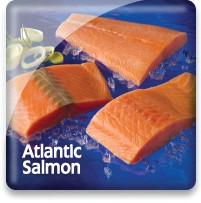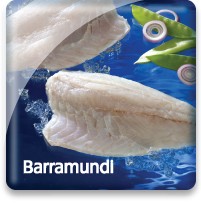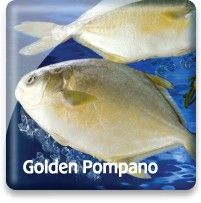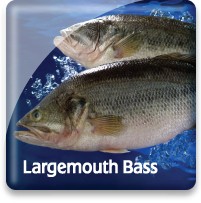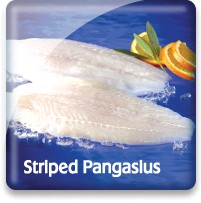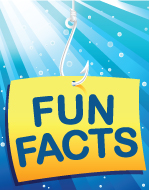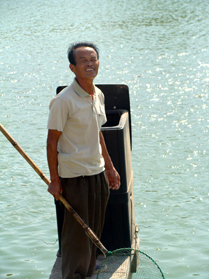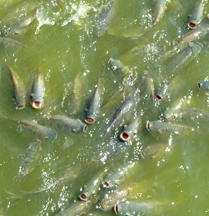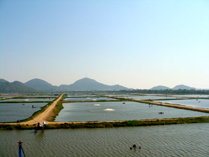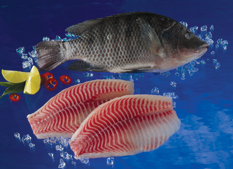
Tilapia

Market Name: Eating QualitiesTilapia is mild and sweet tasting, even somewhat bland. It easily acquires flavor during preparation lending itself to the use of sauces and seasonings. Tilapia meat is white, slightly firm and flaky.
Some species of tilapia carry their eggs in their mouths until the young hatch.
|
Description & CharacteristicsTilapia now ranks as the fourth most popular fish in the United States. Environmental groups as well as the general public have recognized Tilapia to be one of the “greenest” aquaculture products. Tilapia feed at a low tropic level and require little if any fishmeal or fish oil in their feed. Tilapia are very hardy and resistant to disease in typical culture operations. Additionally, Best Aquaculture Practices (BAP) are being used by most of our facilities in China/Taiwan as a standard to assure tilapia is farmed and produced sustainably.Tilapia is often referred to as “St. Peter’s fish” since it is widely believed to be the fish Jesus fed to a congregation of more than five thousand. The tilapia family is quite extensive and frequently reclassified. At present, the major species listed by the FDA Seafood List are O. mossambicus, O. niloticus, and O. aureus. However, for over 40 years commercial breeding programs have created a multitude of hybrid lines predominantly from these three major species and these constantly changing and improving hybrid lines currently dominate commercial Tilapia aquaculture. The Tilapia industry has firmly adopted the concept of improving Tilapia by continuously creating new Tilapia hybrids. Tilapia is a tropical freshwater fish that is being touted as a major aquaculture resource for the future. The fish is extremely hardy, easy to grow and, when added to fish ponds, will survive without much care. These tough creatures have been introduced worldwide and have adapted to many different environments.The fish has a deep, short body with long dorsal fins and spines similar to a sunfish; however, shapes and colorations vary widely among various species and hybrids. The most common farmed tilapia is currently the black or Nile tilapia hybrid often called Nile-Blue Hybrid. More tilapia is farmed worldwide than any other species of fish. It has relatively low start-up costs and is not limited to any one type of environment. It is disease-resistant, has low feeding requirements, and multiplies and grows quickly. Tilapia has a less-than-picky diet and its quick growth has led to it being referred to as an “aquatic chicken.” It is typically grown in freshwater, but various species are tolerant of salinity.Tilapia will generally take on the taste of its environment, therefore the water quality is a critical element in raising quality product. In order to meet the standards of taste requirements, fish that are farmed for the U.S. market are raised in controlled environments. Tilapia farms that supply the U.S. are generally raised in earthen ponds, cement raceways, and cages. Tilapia is also raised in polycultures, such as shrimp ponds, where they may work to control algae growth without eating the shrimp. Many processors ensure the quality of tilapia fillets by the timely bleeding of the fish, deep skinning, and the utilization of packaging innovations.
Other Resources |
Tilapia now ranks as the fourth most popular fish in the United States, according to the 2012 seafood consumption list (go to aboutseafood.com).
Environmental groups as well as the general public have recognized Tilapia to be one of the “greenest” aquaculture products. Tilapia feed at a low trophic level and require little if any fishmeal or fish oil in feed. Tilapia are very hardy and require few drugs or chemicals in typical culture operations. Additionally, Best Aquaculture Practices are being used as a standard to assure Tilapia is farmed and produced sustainably.
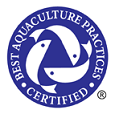
Handling Instructions for Tilapia
Our frozen tilapia is offered as a whole fish, a cleaned and scaled whole fish, and as fillets. All forms must be stored at or below 0°F (-18°C) and then thawed properly when ready to cook. The frozen shelf life is 18 months. Links to proper seafood handling instructions: NOAA - Fish Watch: Handling Seafood and A Consumer Guide to Safe Seafood Handling.
Thawing Tilapia
The whole tilapia should be placed in a tight fitting plastic bag or covered container and placed under refrigeration between 33 and 39°F for 12-24 hours until thawed. Gutting the whole fish once the gut cavity has sufficiently thawed is recommended even if the body of the fish is still mostly frozen. The whole fish can then be allowed to further thaw in the refrigerator. The cleaned and scaled whole tilapia can be thawed is a similar manner without the need for gutting. Fillets can also be thawed in a similar fashion as long as they are removed from any vacuum packaging first before undergoing the thawing process.
Important Instructions for Tilapia
Upon thawing, tilapia should be cooked immediately for the best quality results. Fish not immediately consumed should be held under proper refrigeration (33-39°F) and completely consumed 2-3 days.
The Federal Food, Drug and Cosmetic Act now requires that all foods that are not raw agricultural commodities and that contain a major food allergen be labeled to clearly identify the name of the food source form which the allergen is derived. (21 CFR U.S.C. 343(w)(1)). The act defines eight foods, and any ingredients derived from these foods as major food allergens: Fish, Crustacean Shellfish, Milk, Eggs, Tree Nuts, Peanuts, Wheat & Soybeans. The name of the food source that must be listed on the label for fish or crustacean shellfish must be the specific type of fish or crustacean shellfish. The market names of species of fish and crustacean shellfish should be used to identify the food source of these two major food allergens. If you intend to re-pack these seafood products, be sure the allergen is declared in either one of two ways:
1) Within the list of ingredients
or
2) In a separate “Contains” statement immediately after or adjacent to the list of ingredients.
Consult the Fish and Fishery Products Hazards and Controls Guidance, Fourth Edition, Chapter 19 for more detailed information on the labeling of food allergens.
Cooking Tips
Tilapia can be prepared using a wide variety of cooking methods. Links to cooking tips and recipes.
Taiwan
The island of Tawian, shaped like a tobacco leaf, nation, is located off the coast of China where it is officially part of the Republic of China. Some 23 million people live in an area that is just 245 miles long and 89.5 miles wide, making Taiwan the second-most densely populated country in the world.
While it offers few opportunities for recreational fishing, Taiwan’s commercial fishing industry is well-established, with a fleet of vessels that fish around the world for tuna, sharks, herring, reef fish, horse mackerel, sardines, squid and octopus. Aquaculture is also an important new industry in Tawian, with freshwater farms growing shrimp farms, and tilapia, and marine farms growing shellfish such as clams and oysters.
China
With more than 1.3 billion people, China is today the world’s most populous country. With a growing economy fueling an appetite for seafood, China has begun importing seafood for in-country consumption, as well as exporting a great deal of its production. In fact, since 2002, China has continued to export more fish and fishery products than any other country in the world, with Japan, the United States, and the Republic of Korea as its main export markets.
Chinese distant water fishing activities started in 1985 when China gained access to new fishing grounds through agreements with foreign countries. China operates vessels in West Africa, the North Pacific, and tuna longline vessels in the South Pacific. In addition, squid are harvested in the Japan Sea, the South Atlantic, and the North Pacific under Chinese-flagged vessels.
Carp are also commercially important, as are bream, shad, eel, catfish, rainbow trout, salmon, whitebait, mullet, mandarin fish, perch, sturgeon, and murrel (snakehead). Commercial shellfish include Saltwater & freshwater shrimp, river crabs, and mollusks such as mussels, clams, oysters, and freshwater snails.
With one-fifth of the world’s population, and an official government policy to promote aquaculture, China has today become an aquaculture powerhouse, now producing more than two-thirds of the world’s aquaculture species. Fish and shellfish are grown in freshwater and saltwater environments.
http://cport.net/go-blue-seafood-sustainability-spectrum
|
|
Go Blue! Seafood Sustainability Spectrum*Click here for an explanation of our Sustainability Spectrum 
Sustainability Assessment“Tilapia” is actually the general name for a number of different genera, species, and hybrids of species, of fish in the Cichlid family. Tilapia are an excellent fish to farm: they grow quickly and well on feeds containing small amounts of marine ingredients, breed easily, are relatively resistant to disease, and can tolerate a broad range of water qualities. Generally, these attributes make Tilapia a more environmentally preferable species for aquaculture, but these same factors make them very successful invaders of water bodies where they are not indigenous, and where they can outcompete and exclude native species. Tilapia are native to Africa and the Middle East, but have been introduced to more than 90 countries around the world. In many of these locations, Tilapia have become established in the wild with potentially significant impacts on local ecosystems. It is important that Tilapia farms minimize fish escapes in order to reduce this risk.
Tilapia farming can have low environmental impacts; however, the performance of individual fish farms can vary. Impacts may occur from pollution, misuse of chemicals, spread of disease, fish escapes, and the excess use of feed. These impacts can be more effectively managed through technology and production practices; however, these may not be uniformly applied, especially by small-scale farmers who may not be financially able to do so. Recently many Tilapia farms in China and around the world have started working towards the Aquaculture Stewardship Council’s ASC certification and/or the BAP certification from the Global Aquaculture Alliance. Monterey Bay Aquarium's Seafood Watch lists Tilapia that have achieved BAP 2, 3, & 4 star certifications as "Good Alternatives".
Environmental Impact: ModerateTilapia’s greatest strengths (being a hardy, fast growing and easy breeding species) also give rise to its biggest challenge (being a highly-invasive species that can negatively impact native species). Poor production practices, an issue more common for smaller, less financially secure farmers, may lead to pollution, misuse of chemicals, poor disease control, fish escapes and excessive feed usage.
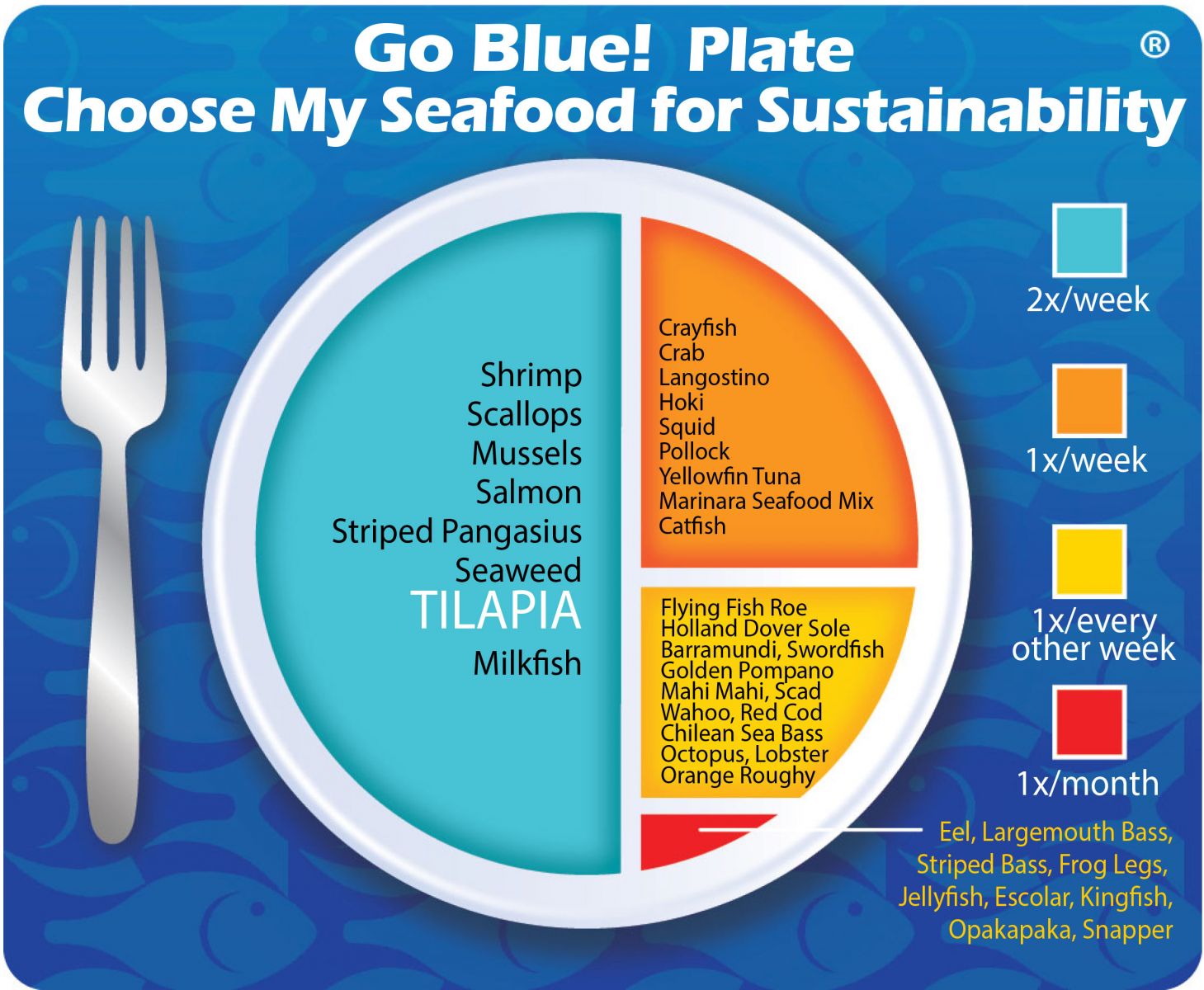
Sustainability Improvements NeededFarms sited in regions where Tilapia are established in the wild should improve their own practices and also work together to reduce the cumulative impacts of their operations on local ecosystems. Farms in areas where Tilapia are not yet established must apply best practices and technology to avoid introducing the fish.
Actions that Sea Port is UndertakingSea Port imports BAP one Star certified Tilapia from China. Sea Port is a Governing Member of the Global Aquaculture Alliance which is actively working with many Tilapia farmers to use their Best Aquaculture Practices (BAP) certification guidelines to further achieve 2, 3, & 4 star ratings. Sea Port believes that Tilapia, which is now the 4th most popular seafood consumed in the U.S., will continue to improve its farming practices as it expands in China and around the world. Sea Port also believes that, in aggregate, choosing from a diverse variety of seafood is better for sustaining the world’s seafood resources and Tilapia is an important contributor to this needed variety. We created the sustainability assessments for each of our seafood items in order to reveal the existing and potential environmental impacts and risks that are associated with producing them for human consumption. This allowed us to establish the starting position for each of our seafood items along our progressive Go Blue! Seafood Sustainability Spectrum®. These assessments are only a single snapshot in time and because of this, we will continue to assess and update the critical sustainability needs associated with our supply sources and issue updates to the Go Blue! Seafood Sustainability Spectrum® as needed. There is a growing global awareness for the need to assure the sustainability of farmed and wild caught seafood and because of this; all around the world positive changes are rapidly occurring at all levels of the seafood supply chain. We will continue to spread this growing awareness and work with our many industry partners to improve the sustainability of all seafood, which we believe is the ideal protein of choice to feed an ever growing world population. Our Go Blue! Seafood Sustainability Spectrum® serves as our compass and yardstick as we strive to move all our products forward to becoming more sustainable. Please join us in this committed quest and Catch Our Wave® to sustainability by choosing a diverse variety of responsibly produced seafood as part of your diet.
|


